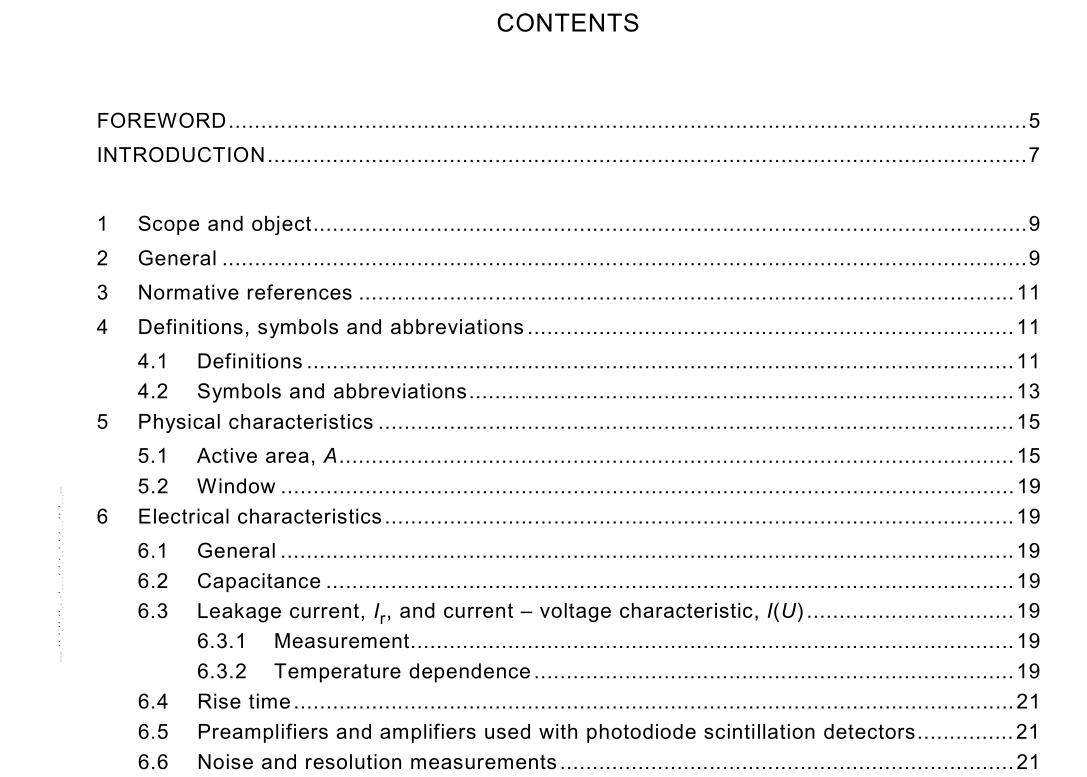IEC 62088 pdf download

IEC 62088 pdf download.Nuclear instrumentation – Photodiodes for scintillation detectors – Test procedures
1 Scope and object
This International Standard applies to solid-state photodiodes (PD) and solid-state photodiode arrays (PDA) used in scintillation detectors or in Cherenkov detectors. Avalanche photodiodes (APD) are also covered by the test methods recommended in this standard, but they need some additional specific tests also described in this standard. Not all tests described in this standard are mandatory, but tests that are used to specify performance should be carried out in accordance with the procedures described herein. The intent of this standard is to establish standard test procedures for photodiodes used in scintillation detectors and to define the parameters which shall be provided by the supplier for each type of photodiode.
2 General
Silicon photodiodes are readily available and widely used in scintillation detection. However, their peak responsivity, around 900 nm, does not match the maximum emission at shorter wavelengths of usual scintillators (NaI(Tl), CsI(Tl), BGO, CdWO 4 , ZnSe(Te)). Research is under way to develop photodiodes from higher bandgap semiconductors or scintillators with longer wavelength light emission.Photodiode scintillation detectors have no internal amplification (except in the case of APDs) and need therefore to be coupled to low noise preamplifiers similar to those used with semiconductor detectors. The noise of the photodiode/preamplifier combination limits its use in low energy gamma ray and X-ray spectrometry. This noise is dominated by the series noise due to the capacitance of the PD, which increases with its area, and by the parallel noise due to the leakage current and the input resistance of the preamplifier. In order to optimize the combination photodiode/preamplifier, the latter is sometimes integrated with the PD. In such a case, some of the tests described hereinafter may be difficult to perform. The solid-state photodiodes can also be used as direct ionization semiconductor detectors, but the present standard does not apply to this application which is already covered by IEC 60333. This standard does not apply to hybrid photodetectors, which are vacuum tubes with a conventional photocathode, an accelerating electric field and a solid state device.
3 Normative references
The following normative documents contain provisions, which, through reference in this text, constitute provisions of this International Standard. For dated references, subsequent amendments to, or revisions of, any of these publications do not apply. However, parties to agreements based on this International Standard are encouraged to investigate the possibility of applying the most recent editions of the normative documents indicated below. For undated references, the latest edition of the normative document referred to applies. Members of IEC and ISO maintain registers of currently valid International Standards. IEC 60050(731):1991, International Electrotechnical Vocabulary – Chapter 731: Optical fibre communication IEC 60050(845):1987, International Electrotechnical Vocabulary – Chapter 845: Lighting IEC 60333:1993, Nuclear instrumentation – Semiconductor charged-particle detectors – Test procedures IEC 61151:1992, Nuclear instrumentation – Amplifiers and preamplifiers used with detectors of ionization radiation – Test procedures
4 Definitions, symbols and abbreviations
4.1 Definitions For the purpose of this International Standard, the following definitions apply. 4.1.1 avalanche photodiode (APD) photodiode operating with a bias electromotive force such that the primary photocurrent undergoes amplification through avalanche breakdown at the junction [IEV 845-05-40]
5.1 Active area, A
The active area of a PD, which is the useful area, is usually slightly smaller than the overall area of the semiconductor wafer. This is due to the packaging or to the electrode or to the protective layer on the junction edge, which may be needed in order to minimize the leakage current (and consequently the noise). Measurement of the active area shall be carried out, as shown in figure 2, by scanning the overall area of the PD placed in total ambient darkness with a collimated beam of incident light from a high stability reference light source. The PD shall be biased and connected to a picoammeter using a conventional set-up as used for semiconductor detector leakage current measurement or current-voltage characteristic plotting (see IEC 60333). Both the spot dimension on the surface of the PD and the scanning step in any direction shall be less than 1/20 of the largest dimension of the semiconductor wafer and, in all cases, less than 0,5 mm (see examples on the right of figure 2). For each scanning path, the measured photocurrent of the PD is plotted as shown in figure 2 and a useful length, x u , is determined as the length of the path where the photocurrent is at least equal to 90 % of its maximum value. The active area, defined as the area where the photocurrent is at least equal to 90 % of its maximum value, is computed from all the individual x u determined for each scanning path. The computation details shall be stated.









